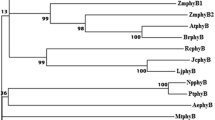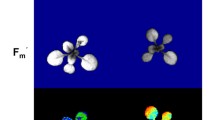Abstract
Irradiation of etiolated Arabidopsis or pea, or dim-red-light-grown pea seedlings with a single, short (under 10 s) pulse of blue light (threshold at 0.1 µmol/m2) is sufficient to induce the expression of specific members of the Lhcb gene family including the pea Lhcb1*4 gene and the Arabidopsis Lhcb1*3 gene. Other Lhcb genes, such as the pea Lhcb1*3 gene and the Arabidopsis Lhcb1*1 and 1*2 genes are unaffected by this blue-light treatment. Transgenic Arabidopsis bearing pea Lhcb1*3::Gus (β-glucuronidase), pea Lhcb1*4::Gus or Arabidopsis Lhcb1*3::Gus constructs were used to determine if pea and Arabidopsis employ a similar mechanism to achieve blue-light induced Lhcb expression. Examination of the respective Gus expression patterns in white-light-grown seedlings indicates that the pea promoters are active and properly expressed in the Arabidopsis background. Irradiation of dark-grown Arabidopsis with a 20 s pulse of blue light with a total fluence of 100 µmol/m-2 results in expression of the pea Lhcb1*4::Gus (β-glucuronidase) construct, but not of the pea Lhcb1*3::Gus construct indicating that the pea promoters respond correctly to blue light in the Arabidopsis background. Fluence-response, time-course and reciprocity characteristics for the blue-light-induced expression of the pea Lhcb1*4::Gus construct closely resemble those of the endogenous Arabidopsis Lhcb genes, confirming the proper interpretation of the Arabidopsis blue-light-signaling mechanism by the pea Lhcb1*4 promoter and suggesting that the signaling mechanisms in the two plants are very similar, if not identical. Fluence response data for the steady-state level of transcript derived from an Arabidopsis Lhcb1*3::Gus construct extending 200 bp upstream of the site of transcription indicate that the blue light responsive element(s) are contained within this 200 bp region.
Similar content being viewed by others
References
Ahmed M, Cashmore AR: HY4gene of A. thalianaencodes a protein with characteristics of a blue-light photoreceptor. Nature 366: 162-166 (1993).
Ahmed M, Lin C, Cashmore AR: Mutations throughout an Arabidopsisblue-light photoreceptor impair blue-light-responsive anthocyanin accumulation and inhibition of hypocotyl elongation. Plant J 8: 653-658 (1995).
Ahmed M, Cashmore AR: Seeing blue: the discovery of cryptochrome. Plant Mol Biol 30: 851-861 (1996).
Alexander L, Flaconet D, Fristensky BW, White MJ, Watson JC, Roe BA, Thompson WF: Nucleotide sequence of Cab-8, a new type 1 gene encoding a chlorophyll a/bbinding protein of LHCII in Pisum. Plant Mol Biol 17: 523-526 (1991).
Ausubel FM, Brent R, Kingston RE, Moore DD, Smith JA, Seidman JG, Struhl K: Current Protocols in Molecular Biology. Wiley, New York (1987).
Barnes AS, Nishizawa NK, Quaggio RB, Whitelam GC, Chua NH: Far-red light blocks greening of Arabidopsisseedlings via a phytochrome A mediated change in plastid development. Plant Cell 8: 601-615 (1996).
Chory J, Cook RK, Dixon R, Elich T, Li HM, Lopez E, Mochizuki N, Nagpal P, Pepper A, Poole D, Reed JW: Signal transduction pathways controlling light regulated development in Arabidopsis. Phil Trans Roy Soc B 350: 59-65 (1995).
Deng X-W, Caspar T, Quail P: cop1: a regulatory locus involved in light controlled development and gene expression in Arabidopsis. Genes Devel 5: 1172-1182 (1991).
Furuya M: Phytochromes: Their molecular species, gene families and functions. Annu Rev Plant Physiol Mole Biol 44: 617-646 (1993).
Gao J, Kaufman LS: Blue-light regulation of the Arabidopsis thalianaCab1 gene. Plant Physiol 104: 1251-1257 (1994).
Huang H, Ma H: Protocol: an improved procedure for transforming Arabidopsis thaliana(Landsberg erectra) root explants. Plant Mol Biol Rep 10: 372-383 (1992).
Jackson JA, Fuglevand G, Brown BA, Shaw MJ, Jenkins G: Isolation of Arabidopsismutants altered in the light regulation of chalcone synthase gene expression using a transgenic screening approach. Plant J 8: 369-380 (1995).
Jefferson RA, Kavanagh TA, Bevan M: Gus fusions:β-glucuronidase as a sensitive and versatile gene fusion marker in higher plants. EMBO J 6: 3901-3907 (1987).
Jenkins G, Christie JM, Fuglevand G, Long JC, Jackson JA: Plant responses to UV and blue light: biochemical and genetic approaches. Plant Sci 112: 117-138 (1995).
Karlin-Neumann GA, Sun L, Tobin EM: Expression of light-harvesting chlorophyll a/b protein genes is phytochrome regulated in etiolated Arabidopsis thalianaseedlings. Plant Physiol 88: 1323-1331 (1988).
Kaufman LS: Transduction of blue-light signals. Plant Physiol 102: 333-337 (1993).
Kaufman LS, Anderson MB, Marsh JF, Kolta K: Initial characterizations of two signal transduction mechanisms capable of altering gene expression in response to a single short pulse of blue light. In: Proceedings of the XII International Symposium on Photobiology. Excerpta Medica, Amsterdam (in press).
Kehoe DM, Degenhardt J, Winicov I, Tobin EM: Two 10-bp regions are critical for phytochrome regulation of a Lemna gibba LHCBgene promoter. Plant Cell 6: 1123-1134 (1994).
Kenigsbuch D, Tobin EM: A region of the Arabidopsis Lhcb1* 3promoter that binds to CA-1 activity is essential for high expression and phytochrome regulation. Plant Physiol 108: 1023-1027 (1995).
Khurana JP, Poff KL: Mutants of Arabidopsis thalianawith altered phototropism. Planta 178: 400-406 (1989).
Koornneef M, Rolff E, Spruit CJP: Genetic control of length inhibited hypocotyl elongation in Arabidopsis thalianaL. Hyenh. Z Pflanzenphysiol 100: 147-160 (1980).
Kwok SF, Piekos B, Misera S, Deng XW: A complement of ten essential and pleiotropic Arabidopsis COPIDETIFUSgenes is necessary for repression of photomorphogenesis in the darkness. Plant Physiol 110: 731-742 (1996).
Li J, Nagpal, Vitart V, McMorris TC, Chory J: A role for brassinosteroids in light-dependent development in Arabidopsis. Science 272: 398-401 (1996).
Lin C, Robertson DE, Ahmed M, Raibekas AA, Dutton PI, Cashmore AR: Association of flavin adenine dinucleotide with the Arabidopsisblue-light receptor CRY1. Science 269: 968- 970 (1995).
Lin C, Ahmed M, Gordon D, Cashmore AR: Expression an Arabidopsiscryptochrome gene in transgenic tobacco results in hypersensitivity to blue, UV-A, and green light. Proc Natl Acad Sci USA 92: 8423-8427 (1995).
Liscum E, Briggs WR: Mutations in the NPH1locus of Arabidopsisdisrupt the perception of phototropic stimuli. Plant Cell 7: 473-485 (1995).
Marrs KA, Kaufman LS: Blue light regulation of transcription for nuclear coded genes in pea. Proc Natl Acad Sci USA 86: 4489-4492 (1989).
Marrs KA, Kaufman LS: Rapid transcriptional regulation of the Caband pEA207 gene families in pea by blue light in the absence of cytoplasmic protein synthesis. Planta 183: 327-333 (1991).
Millar AJ, McGrath RB, Chua N-H: Phytochrome phototransduction pathways. Annu Rev Genet 28: 325-349 (1994).
Mohr H: Coaction between pigment systems. In: Kendrik RE, Kronenberg, GHM (eds) Photomorphogenesis in Plants, pp. 353-373. Kluwer Academic Publishers, Dordrecht, Netherlands (1994).
Quail PH: Phytochrome: a light-activated molecular switch that regulates plant gene expression. Annu Rev Genet 25: 389-409 (1991).
Reed JW, Nagatani A, Elich TD, Fagan M, Chory J: Phytochrome A and phytochrome B have overlapping but distinct functions in Arabidopsisdevelopment. Plant Physiol 104: 1139-1149 (1994).
Short TW, Briggs WR: The transduction of blue light signals in higher plants. Annu Rev Plant Physiol Plant Mol Biol 45: 143-171 (1994).
Sun L, Tobin EM: Phytochrome-regulated expression of genes encoding light-harvesting chlorophyll a/bprotein in two long hypocotyl mutations and wild type plants of Arabidopsis thaliana. Photochem Photobiol 52: 51-56 (1990).
Terzaghi WB, Cashmore AR: Light-regulated transcription. Annu Rev Plant Physiol Plant Mol Biol 46: 445-474 (1995).
Thompson WF, White MJ: Physiological and molecular studies of light-regulated nuclear genes in higher plants. Annu Rev Plant Physiol Plant Mol Biol 42: 423-466 (1991).
Timko MP, Kausch AP, Hand JM, Cashmore AR, Herrara-Estella I, Van den Broeck G, Van Montagu M: Structure and expression of nuclear genes encoding polypeptides of the photosynthetic apparatus. In: Arnczen C, Bogorad L, Bonicza S, Steinbach K (eds) Molecular Biology of the Photosynthetic Apparatus, pp. 381-396. Cold Spring Harbor Press, Cold Spring Harbor, NY (1985).
Warpeha KMF, Kaufman LS: Two distinct blue-light systems regulate the levels of specific nuclear encoded transcripts in pea. Planta 182: 553-558 (1990).
Warpeha KMF, Marrs KA, Kaufman LS: Blue-light regulation of specific transcript levels in Pisum sativum. Plant Physiol 91: 1031-1035 (1989).
Warpeha KMF, Hamm HE, Rasenick MM, Kaufman LS: A blue light activated GTP-binding protein in the plasma membranes of etiolated peas. Proc Natl Acad Sci USA 88: 8925- 8929 (1991).
Warpeha KMF, Kaufman LS, Briggs WR: A flavoprotein may mediate the blue light activated binding of guanosine 5′-triphosphate to isolated plasma membranes of Pisum sativumL. Photochem Photobiol 55: 595-603 (1992).
White MJ, Kaufman LS, Horwitz BA, Briggs WR, Thompson WF: Individual members of the Cabgene family differ widely in fluence response. Plant Physiol 107: 161-165 (1995).
Author information
Authors and Affiliations
Rights and permissions
About this article
Cite this article
Tilghman, J.A., Gao, J., Beth Anderson, M. et al. Correct blue-light regulation of pea Lhcb genes in an Arabidopsis background. Plant Mol Biol 35, 293–302 (1997). https://doi.org/10.1023/A:1005842503952
Issue Date:
DOI: https://doi.org/10.1023/A:1005842503952




